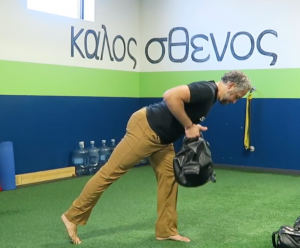2 Exercises to Help Ultimate Sandbag Cleans
2018-11-13

DVRT Master, Cory Cripe (Creator DVRT Movement Strength, DVRT For Weekend Warriors, DVRT Movement Encyclopedia)

If you know DVRT, then you know the power cleans using the Ultimate Sandbag, and it’s what everyone wants to be doing because not only is it a “cool” exercise with all of it’s progressions, but it’s extremely effective, too! It’s such a powerhouse exercise that we use it as a physical competency in order to be certified as a DVRT Instructor – that’s how important it is!
In the fitness world, we call the upward phase of the power clean the concentric movement, whereas the lowering (or down phase) is called the eccentric movement. You may have seen Olympic Weightlifters that after they have cleaned, or snatched, the barbell they let it drop to the floor and same can be said of a Powerlifter after deadlifting huge amounts of weight never lowering the barbell back down, but letting it drop.
https://www.instagram.com/p/BnXLWvzBarm/
It’s not uncommon in neighborhood gyms that the non-competitive lifters are letting barbells slam to the ground, or ::SIGH:: using the weighted plates to bounce the barbell off the floor to help them with their next deadlifting repetition. Why do you suppose these recreational lifters are doing this? Maybe a sense of coolness, but I think there is a fear factor involved. These same individuals are trying to lift as much weight as they can – that’s the easy part – but lowering the barbell with control – now, that’s a whole other monster!
People tend not to get injured during the acceleration (concentric) phase, but when deceleration (eccentric phase) is needed. Think athletes. How many athletes have you seen experience an injury when they sprint down the court? Now how many athletes can you think of who have fallen down in pain when they stop sprinting? Same can be said with jumping. No one hurts themselves jumping up, but landing without control is where hip/knee/ankle injuries occur.
This same mentality isn’t only limited to barbells, dumbbells, and various athletes. We see it happen with our Ultimate Sandbags! So many out there, including myself, can fall into the trap of once we’ve power cleaned the USB to our chest/fists the party is over, repetition one is complete – next rep! The fact is half of that repetition was completed, there is still an opportunity for your body to learn how to properly decelerate as you bring the USB back to the starting position.
https://www.instagram.com/p/BmbKokgF7UL/
When unloading from the top of the power clean, many catch the USB with their elbows and that is made visible by a sudden yank, or jerk, of the arms when stopping the USB’s momentum. The problem with catching the Ultimate Sandbag like this is the negative effects on the joints of the arms. Those who catch with their arms will start complaining about aches and pains in their shoulders, elbows, and wrists.
The great news is this small deficiency with the DVRT Power Cleans is totally curable! Learning how to catch the USB with the hips, and not the arms, is where the magic lies. And the bonus is learning how to decelerate in such a dynamic manner will give you another leg up on real world strength! Winner, winner, chicken dinner! However, it will take patience and mindfulness to really appreciate the lowering and catching of the Ultimate Sandbag (and that in itself becomes a whole new exercise).
Of course, I’m here to help and not leave you hanging! These two DVRT drills have really helped me learn how to catch with my hips and not my arms: Good Mornings and Bent-Over Rows.
Good Mornings
Holding the Ultimate Sandbag in the front loaded position will place major focus on the core during the eccentric phase of this important hip hinge exercise! In a fully extended position, pull the Ultimate Sandbag across your chest by squeezing the shoulder blades together and grab the floor as hard as you can with your feet. This will create the tension necessary to successfully perform a Good Morning. Now, here is where the rubber hits the road: spend 5-7 seconds lowering your body to the bottom and hold for 3-5 seconds. This time under tension is much needed to train the body to catch the USB with the hips after your power cleans. Important note is NOT to let go of the tension initially generated when pausing at the bottom because you’re going to need it to drive up into the top position!
The difference of the barbell version of the good morning means a long lever arm on the low back. The Ultimate Sandbag makes this more of a dynamic plank exercise.
Bent-Over Rows (BOR)
You may think I have made a mistake including a rowing exercise to help you learn how to catch with your hips and not your arms! But, once you can understand how this DVRT drill is predominately an endurance drill for your hip hinge movement, you will appreciate the BOR in a whole new light. When readying yourself to do a power clean, you begin in a hip hinged position, and you need to reclaim the hip hinge while unloading the USB and returning to the starting position. Just like the Good Mornings, I will ask that you spend time under tension while performing the BOR – think 4-5 seconds pulling and a healthy 3-second pause at the top and another 4-5 seconds lowering. Holding a solid hip hinge position with your feet grabbing the ground while pulling a heavy Ultimate is just what this DVRT Master Instructor prescribes to learn how to catch with your hips and not your arms!
Learn more about the powerful ways we teach movement strength training with great programs like Cory’s that you can save 30% off with HERE with coupon code “thanks”
© 2025 Ultimate Sandbag Training. Site by Jennifer Web Design.






